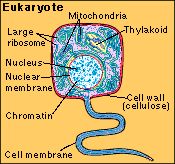Eukaryote

A eukaryotic organism is comprised of cells with distinct nuclei. This means that the cells contain a membrane bound nucleus which encloses the genome, usually arranged on separate chromosomes.
Almost all multicellular organisms are eukaryotic. They first appear on the fossil record 1,500 million years ago, much later than the more primitive prokaryotic cells in which the DNA lies naked within the cell.
The cell biologist Marc Kirschner discusses the evolution of eukaryotic cells.
Figure: eukaryotes (i.e. all plants and animals) have complex cells with a separate nucleus. Within the nucleus the DNA is here illustrated in the diffuse form called chromatin; when the cell divides, the chromatin coalesces into structures called chromosomes.
| Next |



